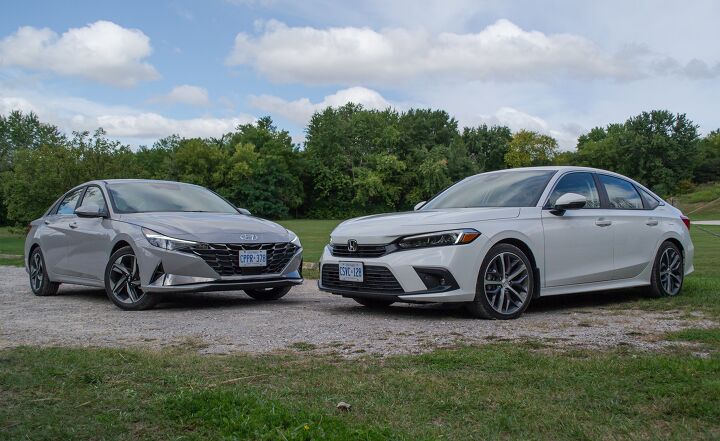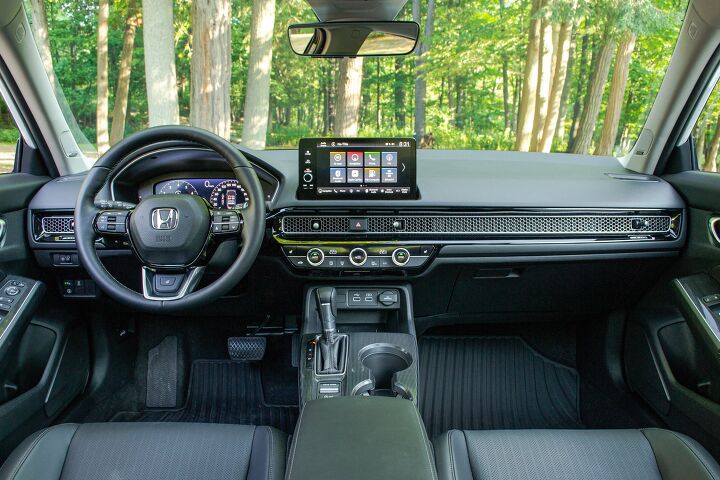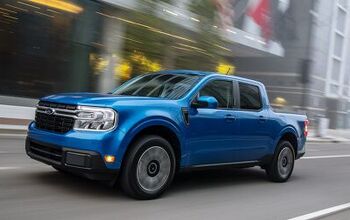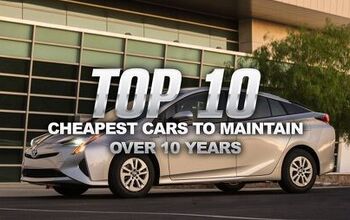Honda Civic Vs Hyundai Elantra Comparison

This is going to be a close one.
In the one corner, Hyundai’s dramatic Elantra. This compact sedan is the reigning AutoGuide Car of the Year, offering buyers a healthy dose of big car space, modern tech, and surprising refinement for not a lot of cash. If you’re not about that SUV life, the Elantra makes a good case for itself as all the car you’d reasonably need.
Facing off with the Elantra is the latest Honda Civic. A juggernaut of the segment, the Civic is a perennial best-seller year after year. The last one was still one of the better options in the segment even as it rode off into the sunset. The 11th-generation model has dialled back the Gundam styling for a simpler look, and brought in more modern tech. Is that enough to take down the current champion? Let’s find out.
Get a Quote on a New Honda Civic or Hyundai ElantraInterior and Cargo Space
Civic: The cleaned-up exterior styling is a preview of what awaits drivers when they pop the Civic’s door open. Inside Honda’s latest, the fussy dashboard design of old is gone. A slimline look is in, with a thin strip of mesh running across the cabin to hide the vents. The important climate controls are easy to access and read, and they come with a premium-feeling click. Honda isn’t immune to the piano black that has spread across the industry, but it sticks to trim pieces that have relatively low finger-traffic. The center console, for instance, has a shiny pinstripe look, which does a much better job hiding smudges.
No matter what part you touch, there’s a real feeling of quality in the new Civic. Plastics are soft, panel gaps are tight, and there’s zero hunting around for controls. It’s also an airy space: Honda made a concerted effort to improve visibility by lowering the beltline of the car. Visibility is improved, and the second row isn’t nearly as claustrophobic.
As the Civic has continued to grow through its 11 generations, the interior space has crept up to near-mid-size levels. The seating position is noticeably lower than the Elantra—that bodes well for the next-gen Type R—providing front passengers with a healthy 37.6 inches (956 mm) of headroom. Leg room is an enormous 42.3 inches (1,074 millimeter), a hair’s width less than the Accord. Rear seat measures are 37.1 and 37.4 inches (942 and 950 mm), respectively. The Civic’s width means three adults can slot into the rear seat without much discomfort, but it’s better if they’re friends. The raised center seat eats into headroom for the middle rider, too.
The low seating position, supportive seat, and right-sized steering wheel make the Civic a very comfortable long-distance cruiser. Lower back support in particular is great. The rear seats are a little flatter, but by no means uncomfortable. And they’re heated, too.
Pop the trunk and this Touring trim offers 14.4 cubic-feet (408 liters) of storage space. That’s fractionally less than other trims. A 60/40 split folding second row is standard across all trims.
Elantra: The Elantra doesn’t target minimalism quite as hard as the Civic. Sure, it does the slim-line, semi-hidden vent trick, too. Combined with the wraparound lower dashboard, it emphasizes the width of the cabin. There’s a more upright dashboard face ahead of the driver though, to house the twin 10.25-inch screens.
Things get busier down on the center console. Like Honda, Hyundai has stuck to a traditional shifter setup here instead of the push buttons found in the Accord and Sonata. Yay! On the flip side, the Elantra sticks its cupholders directly behind the shifter, so you’ll always be grazing a mug or getting jabbed by a straw when shifting. Boo. I’m not as bothered by the big grab handle as some of my colleagues—it’s an interesting design element—but the top seam makes it look like an afterthought. And if you grab it from the driver’s side, as I sometimes do on longer drives, your palm will invariably run right along an ugly seam on the far side. The plastics around the shifter aren’t quite as nice as those in the Civic, either.
Despite being the same height as the Civic, the Elantra boasts over an inch more headroom, with 38.9 inches (989 mm) of hat-friendly air space. Legroom is a Honda-matching 42.3 inches (1,074 mm) up front, as well. The Elantra also offers more space for rear-seat passengers, with 37.3 and 38.0 inches (947 and 964 mm), respectively. The Civic may be wider, but the Elantra has more rear hip room and more shoulder room in both rows. We’re talking an inch (25 mm) or less in most cases. The center perch in the rear is more accommodating for adults, too.
Seat comfort is high up front, though the Elantra’s cushion is flatter than the Civic’s. It misses out on power adjustments for the front passenger, too. Like the Honda, all four outboard seats are heated.
Up to 14.2 cubic feet (402 L) of stuff will fit into the Elantra’s trunk. The opening isn’t quite as squared-off as the Civic’s, however, and while the 60/40 rear row is present here, it isn’t standard on all trims.
Bottom Line: Honda has fitted the Civic with one of the nicest interiors in the segment. Like the Mazda3, it’s classy and high-quality, nipping at the heels of the premium market. The Elantra has very slightly more room, but its inconsistent plastic quality holds it back. The Civic just inches ahead for the first win of this bout.
SEE ALSO: Toyota Corolla vs Hyundai Elantra ComparisonTech and Features
Civic: Perched atop the Civic’s dashboard is a 9.0-inch touchscreen, exclusive to this top Touring trim. It features Honda’s tried-and-true tile-based infotainment system. Not the prettiest of systems, sure, but the color coding does make it easier to use without much thought. This larger screen also features wireless Apple CarPlay and Android Auto, the former of which works flawlessly. Lesser trims use an 8.0-inch screen, and require a cord for smartphone mirroring.
Honda has also dropped in a 10.2-inch digital instrument panel, again exclusive to the top trim. It’s crisp and clean, and chock full of handy information available at your fingertips. Handily, it will display navigation instructions from Apple Maps natively, which is somehow still a rarity in this day and age. Lesser models use traditional analog gauges with a smaller TFT central display.
There are fun Easter eggs, too. Switch to the driver assist view and the dials showcase a little version of the Civic, motoring along a digital roadway. Apply the brakes and the taillights light up; activate a turn signal, and it clicks on on-screen. Neat.
The adaptive cruise control works naturally, leaving gaps—but not too much—from the car ahead. When cars inevitably cut in, the Civic gradually decreases speed.
Finally, the 12-speaker Bose sound system is impressive. It’s capable of plenty of volume, and the clarity stays.
Elantra: A year after its launch and the Elantra’s twin-screen setup is still impressive. A Mercedes A-Class starts for how much more, again? The central 10.25-inch setup runs Hyundai’s latest infotainment system, which is quick and responsive. The design is the more attractive of this duo, but the monochromatic look does make it harder to operate at a quick glance. The lack of a physical home button is also a minor frustration. Out of the two native navigation systems, I prefer the Hyundai system. (Phone map apps are still better than both, though.) Overall, the Hyundai offers more to buyers.
Strangely, if you want wireless Apple or Android support, you have to opt for a lower trim with the 8.0-inch screen.
The second 10.25-inch screen houses the digital instrument panel. Even without a cowl, glare is a non-issue, and the display is quick to respond to inputs from driver or car. If you’re feeling funky, there are four different display themes to cycle between.
Hyundai’s Highway Driving Assist is one of the better adaptive cruise control systems out there. It’s ultra-smooth in its inputs, and will adapt its speed when navigating a curve. Clever stuff.
You’ll find a Bose sound system within the Elantra, too. It’s just eight speakers though, and the resulting sound, while good, isn’t as rich as the experience in the Civic.
SEE ALSO: Toyota RAV4 vs Nissan Rogue ComparisonBottom Line: The new Civic impresses with its tech suite: there’s a lot in here, but it isn’t half as arcane as previous systems. The infotainment system is straight-forward, with a low learning curve. The Elantra’s lineup offers more, with a smoother cruise control system and quicker responses being its biggest strengths. On that basis, it nabs the win here.
Powertrain, Driving Feel, and Fuel Economy
Civic: Up-level Civics (or just the Touring in Canada) feature the 1.5-liter turbocharged four-cylinder. This pint-sized engine kicks out a healthy 180 horsepower and 177 pound-feet of torque. While the hatchback offers a six-speed manual, sedan buyers only have one option: the continuously-variable transmission, sending power solely to the front wheels.
Honda has reworked the CVT for smoother progress and less low-speed hesitation. It makes for a great pairing: the thick wedge of low-end torque means the CVT rarely has to rev the engine high, so the experience isn’t far removed from a traditional torque-converter auto. Dig deeper into the throttle and the power comes in quickly and linearly, making highway passes easy.
The suspension tuning is right there at the top of the class. Honda’s engineers have stuck a fine balance between tied-down body control and straight-line comfort. The 18-inch wheels do make for a stiffer ride than the Elantra, however. The linear, well-weighted steering is a treat, building driver confidence from the first corner. Even in this non-sporty trim, the Civic feels positive down a twisting road. The brake pedal also breeds confidence with strong initial bite.
Honda quotes fuel economy figures of 31 mpg city, 38 mpg highway, and a combined 34 mpg. Canadian figures are 7.6, 6.1, and 6.9 L/100 km, respectively.
Elantra: Every non-N, non-hybrid Elantra uses the same 2.0-liter inline-four cylinder engine. Its vital stats are 147 hp and 132 lb-ft of torque; both less than what the base Civic’s 2.0-liter is capable of.
In isolation, that doesn’t matter much. Hyundai has tuned its CVT very well, making the most of the meagre outputs—and the Elantra’s low curb weight doesn’t hurt. The Elantra will get up to highway speeds without protest, but swapping back and forth between the two, it’s clear the Civic has its number.
SEE ALSO: 2020 Honda CR-V Review: A Cross For The Weekend?The Elantra’s strength lies not in its power, but in its smooth sailing demeanor. The suspension is tuned for comfort, absorbing bumps big and small before they’re transmitted to the cabin. Helping the side are the 17-inch tires, with their thicker, more forgiving sidewalls. The trade off is a chassis less inclined towards corner carving. For that you’ll want the N Line, with its turbo engine and independent rear suspension.
According to the EPA, the Elantra enjoys a small advantage at the pumps over the Civic. It matches the Honda’s 31 mpg city rating, but scores 41 mpg highway, for a 35 mpg average.
Bottom Line: Do you prize comfort above all else? The Elantra is the undisputed cruiser of the duo. But the Civic sacrifices little of that pliancy for better body control and more engaging handling. That turbocharged Honda four-pot is a relative powerhouse too, and barely any thirstier. It’s a Civic win, then.
Safety
Civic: Every Civic trim includes Honda Sensing, a comprehensive suite of driver assists. This includes the usual automated emergency braking, lane departure warning, lane keep assist, and auto high beams. Buyers will also find traffic sign recognition, adaptive cruise control (with Traffic Jam Assist), and rear seat reminder. The Touring trim adds blind spot monitoring with cross-traffic alert and low-speed brake control.
With the 2022 redesign, the Honda Civic scores a Top Safety Pick+ designation from the Insurance Institute for Highway Safety (IIHS). The National Highway Traffic Safety Administration (NHTSA) has yet to test the 11th-generation model, but we predict it will score the same 5-star rating as its predecessor.
Elantra: The Elantra also includes automated emergency braking, lane keep assist, lane departure alert, and auto high beams on all trims. In addition, you’ll find a driver attention warning and safe exit warning. Instead of standard cruise control, the Elantra subs in blind spot monitoring with rear cross-traffic alert. Cruise control isn’t available until the penultimate trim, however, and Hyundai reserves its Highway Drive Assist for the top trim only.
The Elantra has an overall 5-star rating from the NHTSA, with the only blemish on its record being a 4-star front passenger side crash test rating. Over at the IIHS, the Elantra earns a Top Safety Pick rating depending on headlights (this top-spec tester has the right ones).
Bottom Line: In terms of driver aids, these two are evenly matched. Both come with a solid lineup of assists from the base model up (except the base manual-transmission model Elantra in Canada). The Civic out-points the Elantra on available crash test results, so barring any surprises from the NHTSA test, the Civic just noses ahead here.
SEE ALSO: Subaru Outback vs Subaru Forester ComparisonStyling
Civic: Even though the new Civic is a dramatic departure from the 10th-generation model, it shares that car’s divisive nature. Some folks—this writer amongst them—enjoy the tidier, simpler shape. Others think it’s a snooze-fest, and a little too similar to other cars out there (VW’s Jetta, mostly). If you squint a bit, you can see some of the classic ’90s-era Civic shape in that generous glasshouse. The Touring trim gives the shape the necessary large wheels to make the proportions work.
Elantra: Hyundai’s fractal-like styling isn’t for everyone, but you have to admit it’s eye-catching. The Elantra’s ultra-low nose makes the car look much smaller than the statelier Civic. (It’s a boon for parking, too.) We like it, but we wish the available color palette was as adventurous as the styling.
Bottom Line: What a role reversal. In a year, the Civic has become the safer design, the Elantra the bold one. You’ve heard the “styling is subjective” song before, and it still applies here.
SEE ALSO: Honda Civic vs Toyota Corolla: Which Compact Sedan is Right For You?Pricing and Value
Civic: A base Civic will starts at $22,915 ($26,165 CAD), including destination. That nets buyers the 2.0-liter engine, 16-inch steel wheels with covers, LED headlights, cloth interior, and a four-speaker sound system. Honda Sensing is standard. This top-flight Touring trim, with all its bells and whistles, runs $29,910 ($32,265 CAD), with the only option being the Platinum White Pearl paint ($395 / $300 CAD).
Elantra:In America, you can snag a base model Elantra $20,655. Like the Civic, that will net you a 2.0-liter hooked up to a CVT, a cloth interior, and an 8.0-inch touchscreen (with the bonus of wireless Apple CarPlay and Android Auto). Canadians can get into the Elantra for just $19,624 CAD, but that’s with a manual transmission (and thus most of the safety assists nixed). Factor in an extra $1,900 CAD for the CVT. Meanwhile, this top trim runs a very reasonable $26,455 ($30,224 CAD, including the $200 CAD paint).
Bottom Line: The Elantra holds the price advantage across its trim lineup. We’d argue the Civic does feel more upscale, somewhat justifying its higher price. The $3,500 difference between the two in the US—or put another way, 13 percent more cash? A tough sell. $2,000 CAD? A much easier pill to swallow. Either way, it’s the Elantra’s category.
SEE ALSO: Hyundai Elantra N Line vs Volkswagen Jetta GLI Comparison: Healthy CompetitionVerdict: Honda Civic vs Hyundai Elantra Comparison
As we said at the beginning, this was always going to be a close fight. Hyundai has done its homework, creating an ultra-appealing package for the SUV-averse. Every time we’ve driven the Elantra this year, we’ve come back impressed with its combination of space, comfy ride, and modern tech. It’s a damn fine package, and we stand behind the COTY nod.
But we handed down that title before the 11th-generation Civic arrived. Honda’s icon has reasserted its place at the front of the compact pack, with an upscale interior, refined driving dynamics, and a more mature look. Sure, it’ll cost you more, but that’s usually the case when you want the best. And right now, the Civic is it.
Become an AutoGuide insider. Get the latest from the automotive world first by subscribing to our newsletter here.

Kyle began his automotive obsession before he even started school, courtesy of a remote control Porsche and various LEGO sets. He later studied advertising and graphic design at Humber College, which led him to writing about cars (both real and digital). He is now a proud member of the Automobile Journalists Association of Canada (AJAC), where he was the Journalist of the Year runner-up for 2021.
More by Kyle Patrick






















































Comments
Join the conversation
The Civic EX-L is the best choice. Much quicker with the 1.5L Turbo and gets 42 highway. Quickest car with the best mileage of all.
Lease deals?